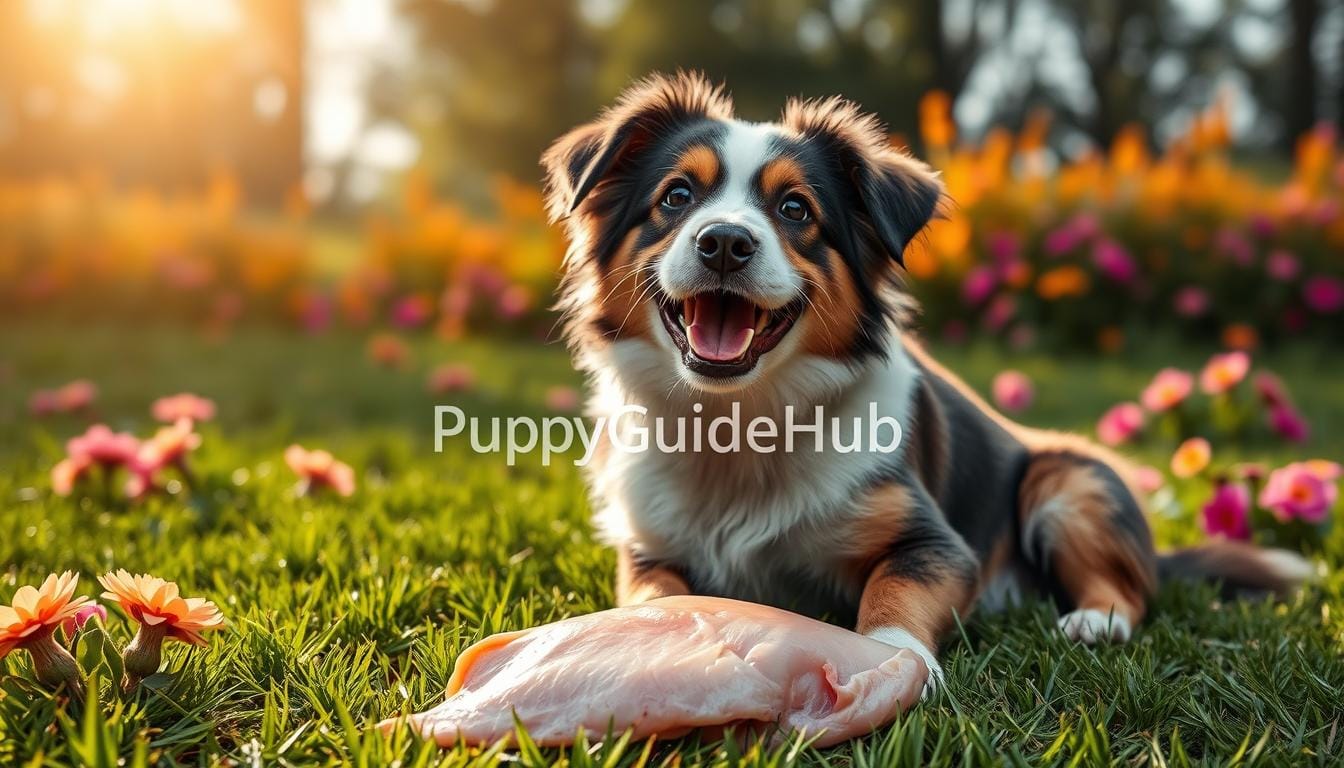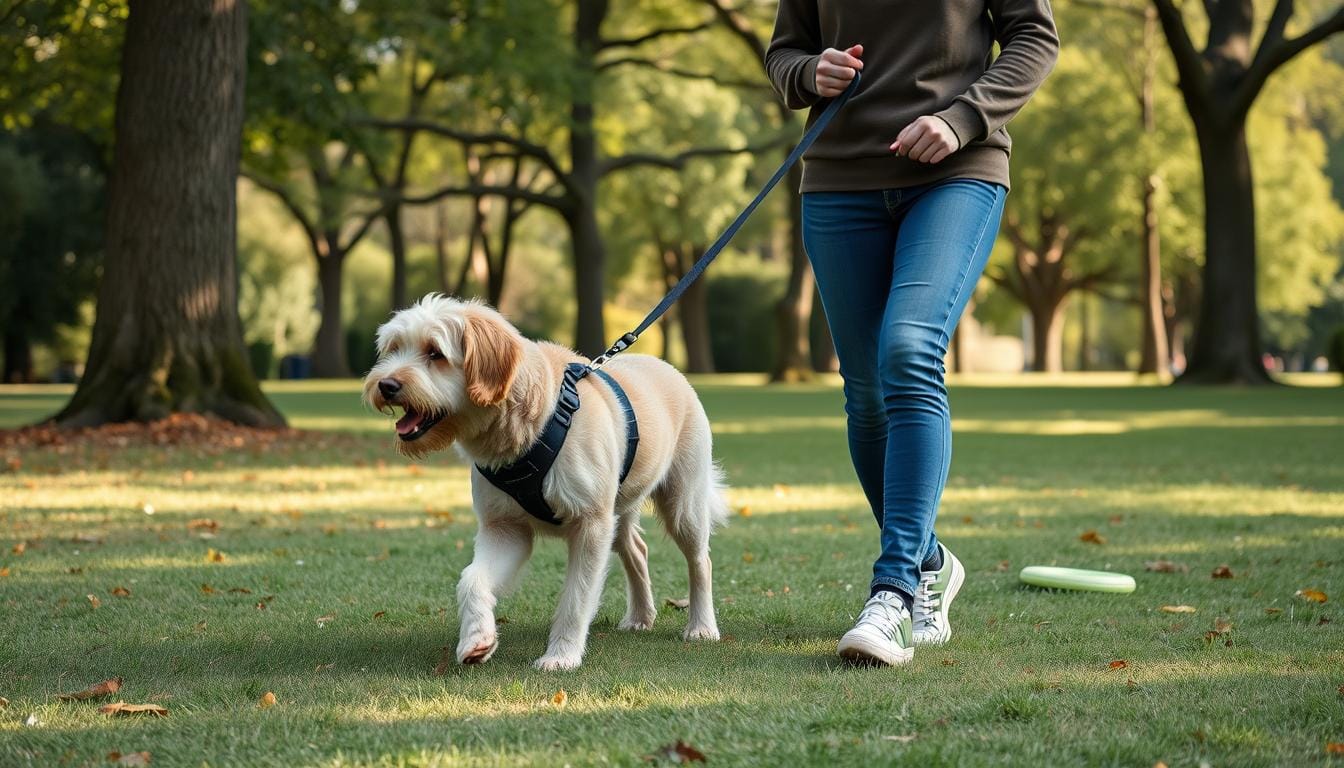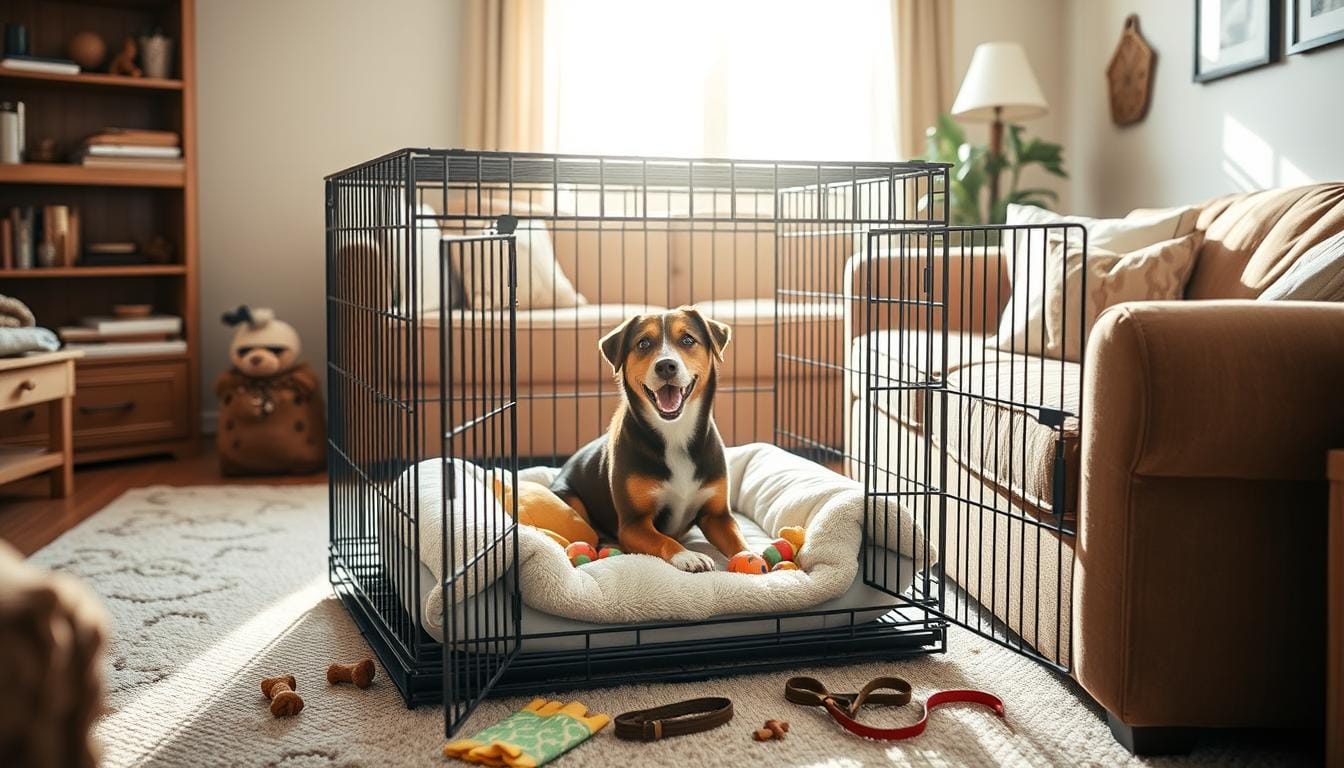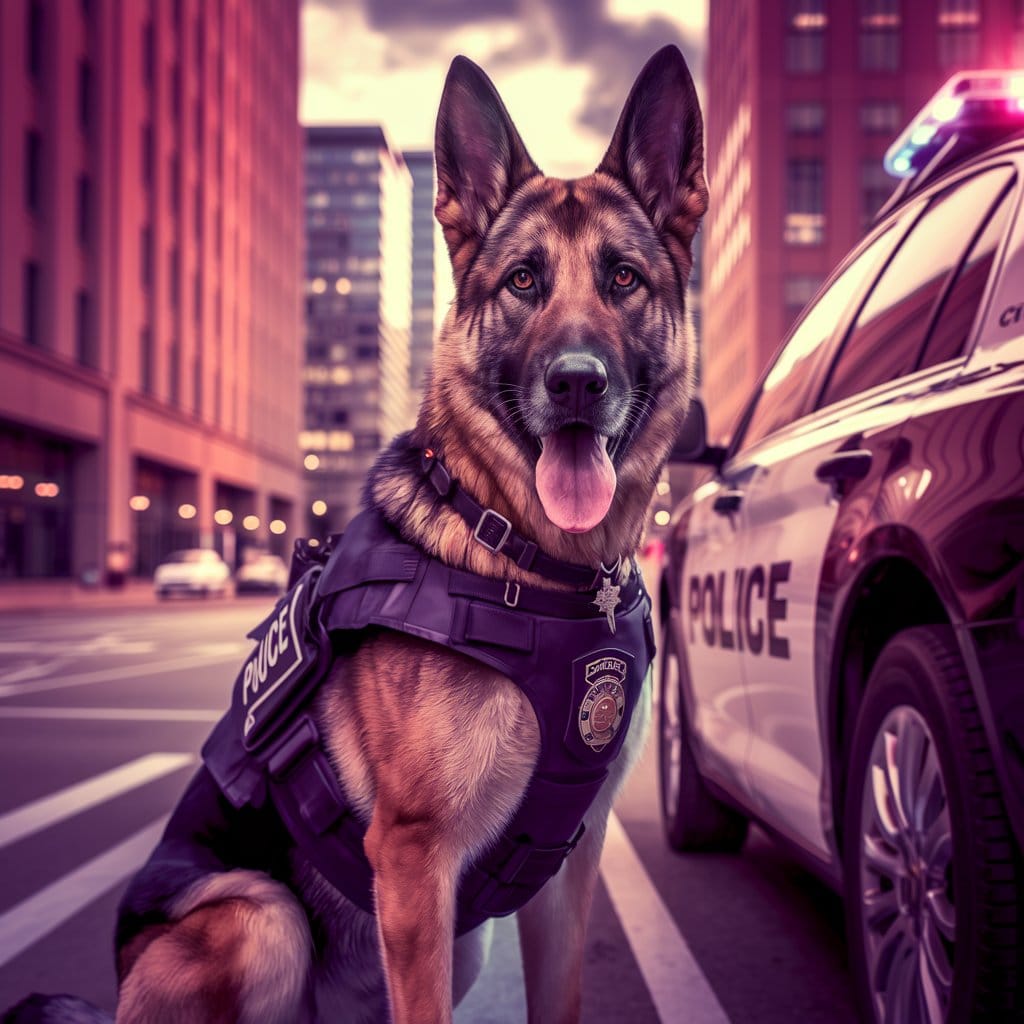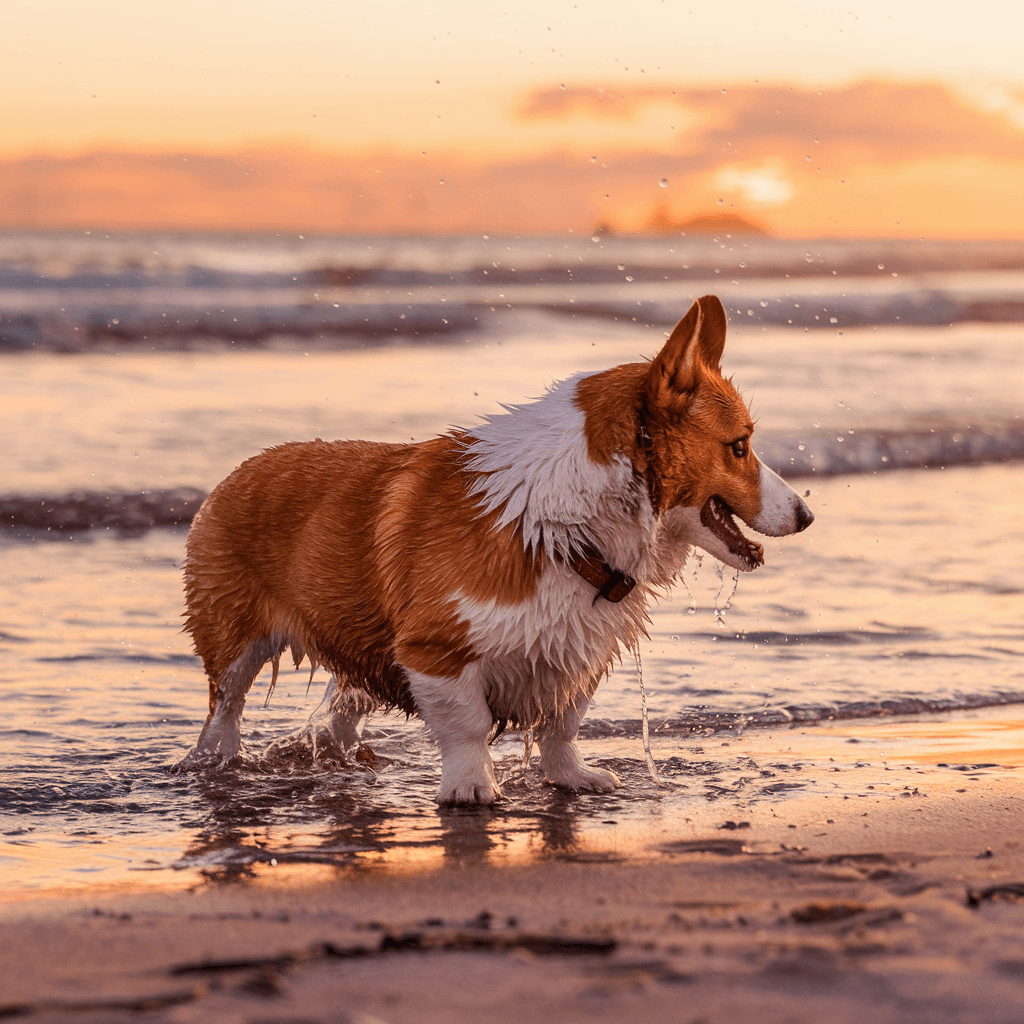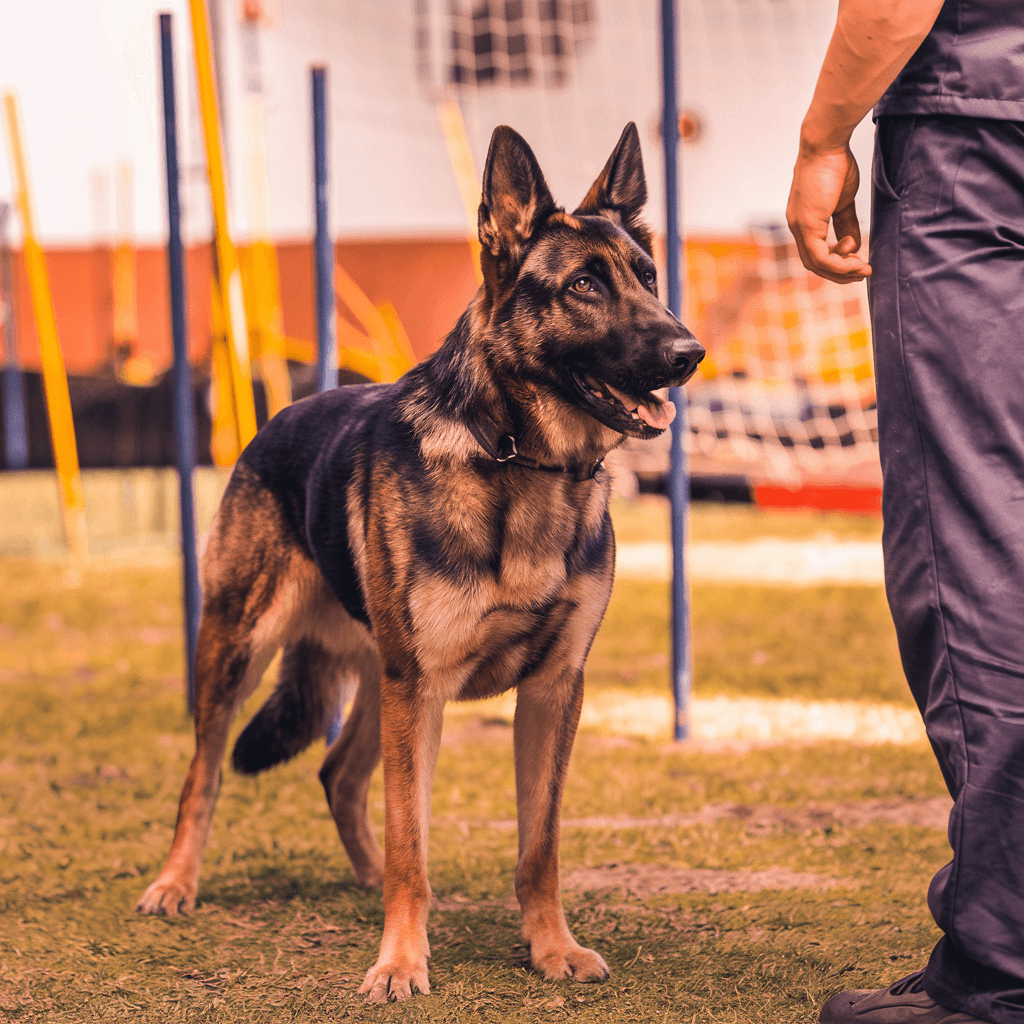Dogs can sense human emotions instinctively. They can read our facial expressions and body language. They even detect changes in our scent.
This emotional intelligence lets them respond to our moods. They offer comfort when we’re sad or share in our joy. Our decisions about their nutrition are deeply intertwined with our bond.
The debate around feeding raw dog food, especially raw chicken, has grown. Pet owners are curious about its effects on their dogs’ diets. This interest comes from a desire to give the best nutrition to our furry friends.
Raw dog food diets, including raw chicken, have both supporters and critics. Some say it improves coat health and boosts energy. Others warn of serious health risks.
The American Veterinary Medical Association and the American College of Veterinary Nutrition advise against raw diets. They point out the dangers.
We’ll look into the origins of raw feeding, its benefits and risks, and expert advice. Whether you’re thinking of switching to raw chicken or just curious, this guide will help. It offers valuable information to navigate this complex issue.
Key Takeaways
- Raw chicken in dog diets is a controversial topic with both potential benefits and risks
- The American Veterinary Medical Association discourages raw diets due to associated health risks
- Raw chicken can pose bacterial contamination risks, including Salmonella and Campylobacter
- Feeding raw chicken exclusively may lead to nutritional imbalances in dogs
- Cooked chicken is generally considered a safer alternative for dogs
- Consulting with a veterinarian is crucial before making significant changes to a dog’s diet
- Proper handling and preparation of raw food is essential to minimize health risks
Understanding the Raw Dog Food Diet
The raw dog food diet is becoming more popular. Pet owners want to give their dogs a natural diet. This diet is based on what dogs’ wild ancestors ate.
Dogs and wolves are very similar, sharing 99.96% of their DNA. This shows how close their diets should be.
Origins of the BARF Diet
The BARF diet started in 1993. It stands for Bones and Raw Food or Biologically Appropriate Raw Food. It’s all about giving dogs uncooked, whole foods like their ancestors ate.
Components of a Raw Dog Food Diet
A raw dog food diet includes:
- Muscle meat
- Raw bones
- Organ meats
- Raw eggs
- Vegetables
- Some dairy products
These foods give dogs a diet rich in protein and other nutrients. But, it’s important to talk to a vet before changing your dog’s diet.
Popularity and Controversy
Even though it’s getting more popular, the raw dog food diet is still debated. Some pet owners love it, but vets have concerns. They worry about health risks and if the diet is balanced.
Most dogs still eat kibble, not raw chicken. But, some owners are choosing raw food for their pets.
| Diet Type | Popularity | Professional Stance |
|---|---|---|
| Kibble | High | Generally accepted |
| Raw Food | Low to Moderate | Controversial |
| BARF Diet | Growing | Mixed opinions |
As the debate goes on, pet owners need to think carefully. They should consider the pros and cons of raw diets. And, they should listen to their vet’s advice.
Potential Benefits of Feeding Raw Chicken to Dogs
Raw chicken is getting more attention for dogs. Many owners see better health and nutrition with raw diets. About 15% to 25% of dogs now eat raw meat.

- Shinier coats and healthier skin
- Cleaner teeth and fresher breath
- Higher energy levels
- Smaller, firmer stools
- Improved digestion and immune function
Raw diets have more antioxidants like vitamin C and E. This might help dogs stay healthier. The fat in raw chicken could also make their coats shinier.
Dogs with food allergies might find relief in raw diets. They offer a new protein source. Some believe raw food helps with other health issues, but more research is needed.
While many owners swear by raw chicken, scientific proof is scarce. Vets emphasize the need for balanced diets. They warn about health risks if raw diets are not handled properly.
“Raw diets can be beneficial for most animals when done correctly,” says Dr. Doug Knueven, a holistic veterinarian.
Raw pet food sales are up by at least 15% each year. This shows pet owners are looking for the best nutrition for their dogs.
Can Dogs Eat Raw Chicken? Exploring the Risks
Feeding raw chicken to dogs is a topic of debate. Some think it’s good, but we must look at the risks. Let’s talk about the dangers of raw chicken for dogs.
Bacterial Contamination Concerns
Raw chicken can be contaminated with harmful bacteria like salmonella. This can cause food poisoning in dogs. Symptoms include vomiting, diarrhea, and fever. Studies show raw pet food is more likely to have these bacteria than other dog food.
Nutritional Imbalances
Homemade raw diets might not have all the nutrients dogs need. It’s hard to make sure the food is balanced without expert advice.
Choking Hazards and Dental Issues
Raw chicken bones can be dangerous for dogs. They might choke or get hurt inside. Some think raw bones are good for teeth, but the risks are too high.
| Risk Factor | Potential Consequences | Prevention Measures |
|---|---|---|
| Bacterial Contamination | Food poisoning, Salmonella infection | Proper handling, Freezing |
| Nutritional Imbalance | Long-term health issues | Consult with a veterinary nutritionist |
| Choking Hazards | Obstruction, Internal injuries | Remove bones, Supervise feeding |
Raw chicken might have some benefits, but the risks are big. Always talk to a vet before changing your dog’s diet. They can help find safe, nutritious options for your dog.
Expert Opinions on Raw Chicken for Dogs
The debate over raw dog food, especially raw chicken, is ongoing. We’ve gathered insights from various professionals to shed light on this controversial topic.
Many veterinarians have concerns about raw chicken in dog diets. The American Veterinary Medical Association discourages raw diets due to health risks. Dr. Lisa Freeman from Tufts University warns of nutritional imbalances and bacterial contamination in raw food.
However, some vets support raw diets. Dr. Doug Knueven advocates for raw feeding but acknowledges it’s not suitable for all dogs. This split in veterinary advice highlights the complexity of the issue.
“95% of veterinarians recommend consulting with them before introducing raw chicken into a dog’s diet.”
Statistics show that 85% of pet owners consider feeding raw chicken to their dogs for perceived health benefits. Yet, 60% worry about bacterial contamination. These numbers reflect the ongoing debate in the pet care community.
Regardless of stance, most experts agree on one point: if choosing a raw diet, do so under professional guidance. This ensures your dog receives proper nutrition tailored to their specific needs.
| Perspective | Percentage |
|---|---|
| Dogs tolerating raw chicken without issues | 70% |
| Pet owners believing raw chicken provides essential nutrients | 45% |
| Pet owners unsure about raw chicken safety | 30% |
When considering changes to your dog’s diet, always seek veterinary advice. Your vet can provide personalized recommendations based on your dog’s health, age, and nutritional needs.
Alternatives to Raw Chicken in Dog Diets
We know raw chicken isn’t for every dog. Let’s explore safer options that still pack a nutritional punch for your furry friend.
Cooked Chicken Options
Cooked chicken is a safer choice for dogs. It’s easier to digest. You can mix it with commercial dog food or serve it as a tasty treat. Remember, moderation is key. A medium-sized dog should have no more than 1/4 cup of cooked chicken per day.
Commercial Raw Food Diets
If you’re set on raw but wary of preparing it yourself, commercial raw food diets might be the answer. These offer convenience and balanced nutrition without the risks of homemade raw meals. They’re formulated to meet your dog’s nutritional needs and often undergo safety checks to minimize bacterial risks.
Homemade Balanced Diets
Homemade dog food can be a great option when done right. It lets you control ingredients and tailor meals to your dog’s needs. But it’s crucial to consult a veterinary nutritionist to ensure you’re meeting all your dog’s dietary requirements.
| Diet Type | Pros | Cons |
|---|---|---|
| Cooked Chicken | Safe, digestible, versatile | Needs balancing with other nutrients |
| Commercial Raw | Convenient, balanced | More expensive |
| Homemade Balanced | Control over ingredients | Time-consuming, requires expert guidance |
Whichever option you choose, always transition slowly to new foods. Your dog’s health comes first, so don’t hesitate to reach out to your vet with any concerns.
Safe Handling Practices for Raw Chicken
When preparing raw chicken for dogs, food safety is key. We must follow strict guidelines to protect our pets and ourselves. Let’s look at important practices for dog food preparation to reduce health risks.

First, wash your hands well with soap and water for at least 20 seconds before and after handling raw chicken. This simple step greatly lowers the risk of bacterial contamination. Use separate cutting boards and utensils for raw meat to avoid cross-contamination with other foods.
Store raw chicken in sealed containers in the fridge, away from other foods. When preparing the meal, use dedicated areas for raw food handling. After preparing, clean all surfaces, utensils, and bowls with hot, soapy water or a sanitizing solution.
| Raw Chicken Part | Nutritional Benefits | Handling Considerations |
|---|---|---|
| Breast | Low-fat, high-protein | Remove skin, trim excess fat |
| Thighs | Higher fat content | Feed in moderation |
| Wings | Good meat-to-bone ratio | Monitor for small bones |
| Gizzards | Rich in vitamin B12 | Clean thoroughly before feeding |
By following these food safety practices, we can lower the risks of raw chicken while giving our dogs a nutritious meal. Always consult with a vet before making big changes to your dog’s diet.
When to Avoid Feeding Raw Chicken to Dogs
Raw chicken can be good for some dogs, but not all. We must think about health conditions and nutrition before adding raw food to their diet.
Health Conditions That Contraindicate Raw Diets
Dogs with certain health problems should avoid raw chicken. Those with weak immune systems, cancer, or on chemotherapy face higher infection risks. Also, dogs with severe kidney or liver issues should not eat high-protein raw diets.
Age Considerations for Puppies
Puppies need the right nutrition for growth. Raw diets can be risky for them because they’re more likely to have nutritional imbalances. These can cause growth problems and bone issues. It’s wise to give raw chicken to puppies slowly and in small amounts, considering their still-developing digestive systems.
| Dog Group | Raw Chicken Suitability | Reason |
|---|---|---|
| Immunocompromised | Avoid | Higher infection risk |
| Late-stage kidney/liver failure | Avoid | High protein not suitable |
| Puppies | Introduce slowly | Risk of nutritional imbalance |
| Dogs with pancreatitis | Start with cooked | Digestive sensitivities |
Always talk to a vet before changing your dog’s diet, especially with raw food. This helps ensure your dog gets the right food for their health while avoiding risks.
Transitioning to a Raw Food Diet
Switching to a raw dog food diet needs careful planning and a gradual approach. We suggest a step-by-step method to make the transition smooth and avoid digestive problems.
Begin by adding small amounts of raw food to your dog’s meals. Slowly increase the raw food portion over 1-2 weeks. This gradual change helps your dog’s digestive system adjust to the new diet.
Keep a close eye on your pet’s health and digestion during the transition. Look for signs of discomfort or changes in stool. If you see any issues, slow down the transition pace.
- Week 1: Replace 25% of regular food with raw food
- Week 2: Increase raw food to 50%
- Week 3: Move to 75% raw food
- Week 4: Complete transition to 100% raw food
It’s wise to consult a vet or veterinary nutritionist to ensure the diet is right for your dog. They can help create a balanced meal plan based on your dog’s age, size, and health.
Remember, every dog is different, and some may need a slower transition. Watch how your pet responds and be ready to make adjustments. With patience and careful monitoring, you can help your dog thrive on a raw food diet.
Conclusion
The debate about raw chicken for dogs shows how complex pet health and nutrition can be. We’ve looked at both sides, weighing the good against the bad. Raw diets might improve a dog’s coat and teeth, but they also come with big risks.
Raw chicken can carry harmful bacteria like Salmonella and Campylobacter. These can make dogs very sick, causing fever, diarrhea, and vomiting. There’s also the risk of choking on bones and not getting the right nutrients.
Feeding raw chicken to dogs is a big decision. We advise talking to a vet before changing your dog’s diet. For many, a good commercial dog food or cooked meals are safer and still nutritious. Every dog is different, so what’s best for one might not be for another. Always put your pet’s health and safety first when deciding what to feed them.

